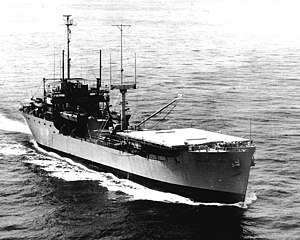
USNS Kingsport (T-AG-164) was built as SS Kingsport Victory, a United States Maritime Commission VC2-S-AP3 (Victory) type cargo ship. During the closing days of World War II the ship was operated by the American Hawaiian Steamship Company under an agreement with the War Shipping Administration. After a period of layup the ship was operated as USAT Kingsport Victory by the Army under bareboat charter effective 8 July 1948. When Army transports were transferred to the Navy's Military Sea Transportation Service the ship continued as USNS Kingsport Victory (T-AK-239), a cargo transport. On 14 November 1961, after conversion into the first satellite communication ship, the ship was renamed Kingsport, reclassified as a general auxiliary, and operated as USNS Kingsport (T-AG-164).
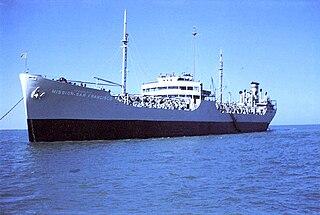
USNS Mission San Francisco (T-AO-123) was a Mission Buenaventura-class oiler that served in the United States Navy. The ship was originally intended as USS Contoocook (AO-104) for the U.S. Navy but her acquisition was canceled. The ship, a Type T2-SE-A3 tanker, was completed as SS Mission San Francisco and delivered after the end of World War II. The tanker was acquired by the U.S. Navy in 1947 as USS Mission San Francisco (AO-123), but was transferred to the Military Sea Transport Service (MSTS) upon its creation in 1949. During a second stint with the MSTS that began in 1954, Mission San Francisco collided with the freighter Elna II in the Delaware River coast and was declared unsalvageable by the U.S. Navy. The ship was one of two U.S. Navy vessels named for the Franciscan mission of San Francisco de Asís located in San Francisco, California.
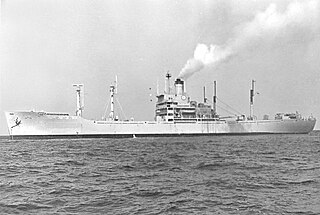
USNS Dutton (T-AGS-22) was an oceanographic survey ship for the United States Navy from the late 1950s through the 1980s. She was launched as SS Tuskegee Victory in 1945, Maritime Commission hull number MCV 682, a type VC2-S-AP3 Victory ship. In her U.S. Navy service, she was named after Captain Benjamin Dutton, Jr., and was the second U.S. Navy ship named in his honor.

USNS Sgt. Jonah E. Kelley (T-APC-116), was originally built as Link Splice under a United States Maritime Commission contract and was laid down on 29 January 1945 by the Southeastern Shipbuilding Corporation in Savannah, Georgia. She was launched on 17 March 1945, sponsored by Mrs. L. W. Grothaus and delivered to the War Shipping Administration for operation by the Moore McCormack Lines on 28 August 1945.

USNS Bowditch (T-AGS-21) was the lead ship of her class of oceanographic survey ships for the United States Navy. Launched as the SS South Bend Victory in 1945, Maritime Commission hull number MCV 694, a type VC2-S-AP3 Victory ship, she was named for Nathaniel Bowditch, the second U.S. Navy vessel named in his honor. The ship was acquired by the Navy in August 1957 and converted to an AGS at Charleston Naval Shipyard. Named Bowditch on 8 August 1957 and placed in service 8 October 1958 for operation by the Military Sea Transportation Service (MSTS).
USNS Michelson (T-AGS-23) was a Bowditch class oceanographic survey ship of the United States Navy. Launched as the SS Joliet Victory in 1944, Maritime Commission hull number MCV 114, a type VC2-S-AP3 Victory ship, she was named after Albert Abraham Michelson. The ship was reactivated from the James River Maritime Administration Reserve Fleet on 8 February 1958, delivered to the Navy Department at the Philadelphia Naval Shipyard on 8 August 1957 and converted to an AGS by the Charleston Naval Shipyard. USNS Michelson (AGS‑23) was placed in service on 15 December 1958 under the operational control of MSTS Atlantic.
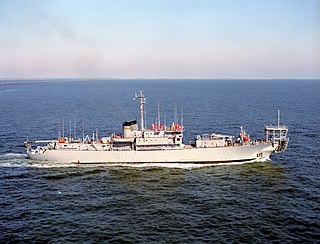
USNS Albert J. Myer (T-ARC-6) was the second of only two Maritime Commission type S3-S2-BP1 ships built for the US Army near the end of World War II intended to support Army Signal Corps communications cables. She is named for Brig. Gen. Albert J. Myer, the founder of the Signal Corps. The other ship was the William H. G. Bullard, later USS Neptune, which Myer later joined in naval service.
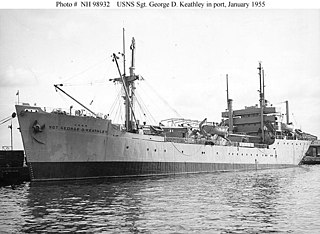
USNS Sgt. George D. Keathley, was a World War II United States cargo vessel that was used for troop transport and later converted to a survey vessel. She was laid down and launched as MS Alexander R. Nininger, Jr., then renamed MS Acorn Knot. She was put into US Army service as USAT Acorn Knot, then renamed USAT Sgt. George D. Keathley. She was transferred to the US Navy and became USNS Sgt. George D. Keathley (T-APC-117), but was later re-designated T-AGS-35. She was leased to the Republic of China, where she served as Chu Hwa (AGS-564). Both Nininger and Keathley were posthumous Medal of Honor recipients.
USNS Sgt. Joseph E. Muller was a C1-M-AV1 cargo ship completed 9 June 1945 and delivered to the War Shipping Administration (WSA) as Check Knot. After operation by WSA's agent Waterman Steamship Company June 1945 – November 1946 and being placed in reserve the ship was transferred to the U.S. Army and renamed USAT Sgt. Joseph E. Muller. She was transferred to the United States Navy in 1950 after the establishment of the Military Sea Transportation Service under Navy and assigned to Korean War supply and transport operations. She was again place back in service in 1962 as one of the civilian crewed, Auxiliary General (AG), technical research ships working on National Security Agency/Naval Security Group missions, based out of Florida. She was finally declared surplus to needs in 1969 and struck.

USNS James M. Gilliss (T-AGOR-4) was a Robert D. Conrad-class oceanographic research ship acquired by the U.S. Navy in 1962. The ship was operated by the Military Sea Transportation Service and managed by the Naval Oceanographic Office as one of the "Navy Pool" vessels serving various Navy laboratories and projects in the Atlantic Ocean. After active Navy pool service the ship was assigned to the University of Miami to operate as part of the University-National Oceanographic Laboratory System (UNOLS) fleet until 1979.
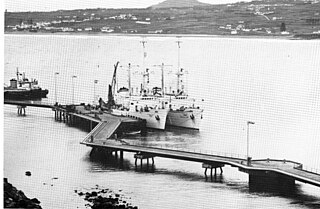
USNS Sands (T-AGOR-6) was a Robert D. Conrad-class oceanographic research ship operated by the Military Sealift Command (MSC) for the Naval Oceanographic Office from 1965 to 1973. During that period she provided ocean-bottom information and underwater test data to the U.S. Navy and other U.S. agencies. The ship was the second naval vessel to be named for Rear Admiral Benjamin F. Sands and his son Rear Admiral James H. Sands, the first being the destroyer Sands (DD-243). The ship operated in the Atlantic on oceanographic and geophysical assignments for the Oceanographic Office and other agencies.

USNS Eltanin (T-AK-270/T-AGOR-8) was an Eltanin-class cargo ship with an ice-breaking hull acquired by the U.S. Navy in 1957 and then operated by the Navy in a non-commissioned status, named after Eltanin, a star in the constellation Draco. Her designation was changed to that of an oceanographic research ship in 1962 when she operated in Antarctic waters.

USNS Bartlett (T-AGOR-13) was a Robert D. Conrad-class oceanographic research ship acquired by the U.S. Navy (USN) in 1969. She was named after oceanographer Captain John R. Bartlett of the USN. Bartlett was one of the ships under the technical direction of the Naval Oceanographic Office (NAVOCEANO) operating as an Auxiliary General Oceanographic Research (AGOR) program "pool" ship for support of Navy laboratories on each coast as well as NAVOCEANO projects. The ship was first assigned to support laboratories on the West Coast with last operations in similar support on the East Coast and Atlantic.

USNS Sgt. Andrew Miller (T-AK-242) was built as Victory ship SS Radcliffe Victory, a Boulder Victory-class cargo ship, built at the end of World War II. She served during the war and its demilitarization as a commercial cargo vessel operated by American West African Lines under charter with the Maritime Commission and War Shipping Administration. From 1946 to 1950, she served the US Army as a transport named USAT Sgt. Andrew Miller. In 1950, she was acquired by the US Navy and assigned to the Military Sea Transportation Service (MSTS). In 1981 she ended her career and was placed into reserve.

USNS Sgt. Archer T. Gammon (T-AK-243) was a Boulder Victory-class cargo ship built at the end of World War II and served the war and its demilitarization as a commercial cargo vessel. From 1946 to 1950 she served the U.S. Army as a transport named USAT Sgt. Archer T. Gammon. In 1950 she was acquired by the United States Navy and assigned to the Military Sea Transportation Service. In 1973 she ended her career and was struck and scrapped.
USNS Sgt. Truman Kimbro (T-AK-254) was a Boulder Victory-class cargo ship built for the U.S. Maritime Commission during the final months of World War II as the SS Hastings Victory.
USNS Flyer (T-AG-178), was a type C2-S-B1 cargo ship of the United States Navy, built for the Maritime Commission (MC) as Water Witch in service under charter by the Commission to several lines until purchased in 1946 by United States Lines and renamed American Flyer. After being placed in the Reserve Fleet 14 December 1964 the title was transferred to the Navy for use as a deep ocean bathymetric survey ship supporting installation of the Sound Surveillance System (SOSUS). The Navy placed the ship in service 9 February 1965 with the name Flyer given on 22 March. The ship operated in that role until 1975.

USNS Chauvenet (T-AGS-29) was a multi-function survey ship laid down on 24 May 1967, at Upper Clyde Shipbuilding Corp., Glasgow, Scotland. The ship was the second survey ship, Chauvenet (AGS-11) being the first, named for William Chauvenet (1820-1870). He was instrumental in the founding of the United States Naval Academy at Annapolis, MD. The mathematics department of the US Naval Academy in Annapolis was founded by Chauvenet and is housed in Chauvenet Hall. Chauvenet was launched on 13 May 1968, delivered to the US Navy, 13 November 1970 and placed in service with the Military Sealift Command (MSC) as USNS Chauvenet (T-AGS-29). The ship conducted coastal hydrographic and topographic surveys under the technical direction of the Oceanographer of the Navy through the U.S. Naval Oceanographic Office (NAVOCEANO). The ship was assigned to the Pacific for surveys, sister ship Harkness (T-AGS-32) was assigned Atlantic duties, doing so until inactivated in November 1992.

NOAAS George B. Kelez, previously NOAAS George B. Kelez, was an American research vessel in commission in the National Oceanic and Atmospheric Administration (NOAA) fleet from 1972 to 1980. Prior to her NOAA career, she operated under the United States Fish and Wildlife Service′s Bureau of Commercial Fisheries from 1962 to 1970 as US FWS George B. Kelez and the National Marine Fisheries Service from 1970 to 1972 as NOAAS George B. Kelez.
